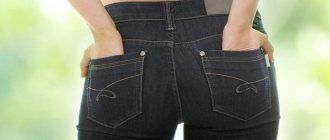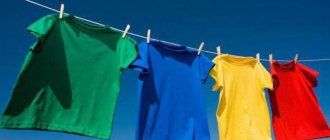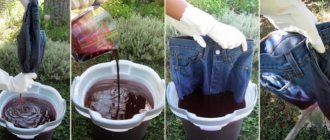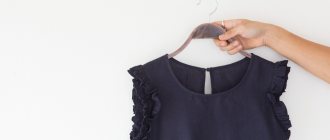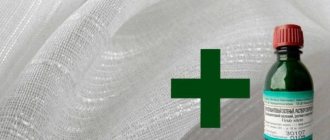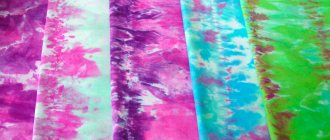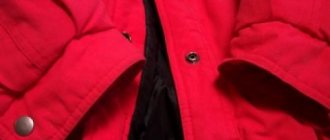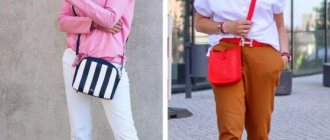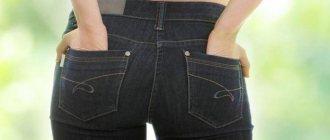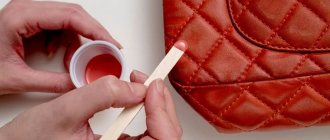What fabric can be re-dyed?
First of all, I would like to clarify which fabric can be re-dyed and what nuances should be taken into account before choosing a dye and the process itself.
- Before purchasing fabric dye, look at the clothing label on the label. This will help you decide on the most optimal paint for color restoration and painting method. If you don’t know the nature of the material, buy universal dyes for any type of fabric.
- The most rewarding material in terms of re-dying is natural fabrics: linen, cotton (cotton), silk, wool. Mixed material containing 30-40 percent natural components also works well. As for synthetic clothing, its restoration should be entrusted to dry cleaning, because... Often, when dyeing it at home, the paint is quickly washed off during washing. However, fortunately, today there is a special fabric paint that is suitable for 100% synthetics. It will be discussed below.
- We also note that white fabric can be dyed in any color: from light to black tones. As for dark clothing, it is possible to restore the original shade with the appropriate paint tone. If you need to radically repaint, such clothes must first be bleached, for example, with a white solution.
- A certain fabric composition differs in density and fiber characteristics, and this should be taken into account when restoring color. So, thick cotton or denim is the most unpretentious fabric. Therefore, when working with it, you can choose any painting method.
- Wool and silk fabrics do not react well to the boiling process, so it is better to dye them in a washing machine on a gentle cycle. In this case, paints are used that are activated at temperatures less than 95 degrees, such as vat paints.
Fabrics made from natural fibers are best dyeable.
Staining algorithm
The first step is to put the jacket on a mannequin or hanger. To prevent the skin from hanging in folds, you can place old towels under the shoulders, back, and collar. Painting on a horizontal plane is also acceptable, but it is not always convenient.
How to paint a black or any other jacket step by step:
- moisten a cotton swab in acetone mixed with water or alcohol and wipe the surface of the product - this will help remove the protective wax;
- Using a brush, lubricate the skin with a gelatin solution: dilute a tablespoon of powder in 250 ml of cold water, heat to dissolve the crystals;
- stand for 30 minutes, meanwhile preparing the composition for painting;
- Apply paint first to the most worn areas, and then to the entire surface.
It is important to carefully paint the seams on the sleeves, collar, and around the fasteners.
It is better if the leather jacket is painted at +16–20 degrees and normal air humidity - no more than 75%. It is recommended to open the windows in the room and keep the lighting bright.
Each type of paint for a leather jacket, black, brown or white, has its own nuances of use.
| Means | How to apply correctly |
| Sprays | Hang the product on hangers, and from a distance of 28–32 cm, spray the composition in one even layer over the entire surface of the skin. Let the paint soak in. Afterwards, wipe the surface of the jacket with a soft cloth. |
| Liquid formulations | Dilute the composition with water in a basin. Dip the product into the coloring pigment, making sure that it is evenly saturated with it on each side. After dyeing, treat the surface of the jacket with a solution of warm water, vinegar and table salt. |
| Creamy substances | Squeeze the paint onto a sponge and cover the entire jacket. Wait until the substance is completely absorbed and the surface of the skin becomes dry. |
| Powder dye | Before work, dilute the substance in water at 35–40 degrees, transfer it to a large container, add 2 liters of water and boil. When the composition has cooled to a temperature of 40–45 degrees, lower the jacket into the container. To paint it black (or any other color), be sure to turn the product over several times. After the required time has passed, remove the jacket from the solution, squeeze out the moisture and rinse with clean water. |
Drying time is individual, approximately it is indicated in the instructions compiled by the paint manufacturer. You cannot use a hair dryer or any other electric heat devices to speed up the process. Drying should take place under natural conditions.
Degrease the surface of the jacket
Apply gelatin solution with a brush, leave for 30 minutes
Paint the worn areas first, then the entire surface.
To speed up the drying process, do not use a hair dryer or heater.
Types of fabric paints
There is a huge selection of fabric paints. This is due to the great demand for unique color schemes in the design of clothing, fabric interior items and the enormous popularity of this type of applied art such as painting on fabric. Therefore, to answer the question of what can be used to dye fabric, let’s look at the types of dyes, both in terms of release form and composition.
Forms of release and color fastness
Fabric paints sold in specialized stores, depending on the form of release, are divided into:
- Powders
- Pastes
- Liquids
- Special markers (felt-tip pen) and outlines
- Sprays
If you plan to dye the fabric completely, then it is more convenient and faster to use powder, paste or liquid. Markers are primarily intended for painting on fabric. Sprays are easy to use because... they do not need to be diluted before dyeing, they are simply applied to the clothes. They are also optimal for multi-color painting.
Depending on the degree of color fastness, dyes are either washable or indelible. Washable ones are great for temporarily transforming clothes and are washed out in 1-3 washes. As a rule, these are natural dyes. Leave-in formulations are relevant for one-time color renewal. They are lightfast and waterproof.
Various options for release forms of fabric dyes
Paint selection
Preparation for the painting procedure begins with choosing a quality product. They are classified according to different criteria. Dyes are:
- Penetrating. They are absorbed into the deep layers of the material and are designed to completely repaint the product from color to color. Suitable for all skin types.
- Superficial. They have a thicker consistency. Effectively covers scratches, cracks, and small abrasions on smooth leather products. Such dyes are not suitable for aniline, exotic leathers (for example, crocodile leather), suede, nubuck, and velor.
Tip: To determine what type of skin you have, you can do a test with a drop of water. A drop of water is applied to an inconspicuous area of the item. If the drop is absorbed and leaves a dark halo, then penetrating dyes must be selected for the product. If the drop remains on the surface, then surface dyes are suitable.
Paint release form:
- aerosol product;
- liquid;
- dry powder.
It is worth paying attention to the composition of the dye. It is best to choose a water-based product without toxic ingredients.
A good sign will be the content in the paint:
- Wax. It gives things shine, softens, smooths out cracks, and removes abrasions.
- Nut oils. It smoothes the surface.
- Olive or jojoba oils. They have nutritional and protective properties.
- Mink oils. It takes good care of the product.
- Seal oil , which has water-repellent characteristics.
Types of pigments by composition
Depending on the composition, there are natural dyes (tea, coffee, etc.) and synthetic ones sold in stores. Ready-made materials are easy to use and include the following types of paints:
- Acrylic
- Aniline
- Stamp
- Plastisol
- VAT
This article discusses ready-made fabric dyes that are sold in stores. We will discuss dyeing things with natural substances such as tea, coffee, and beets in another material.
To choose the optimal composition for dyeing fabric, we will dwell in more detail on each type of dye.
Pants before and after dyeing
Acrylic paints
One of the most popular materials for fabrics is acrylic paints. It is distinguished by a huge selection of assortments. There is acrylic with mother-of-pearl, shiny, silver, luminous, etc. This is due to the inertness of the acrylic paint base, due to which manufacturers include various additional components in it to give specific effects.
Dye for synthetic fabric
Most common dyes are not suitable for synthetic fabrics. Fortunately, there is an answer to the question: “How to paint synthetics?”
Jacquard iDye Poly is an American dye for 100% synthetic fabrics such as polyester, nylon, etc. This is an innovative product for dyeing artificial fabric at home.
The use of such a dye is comparable to the manual dyeing method, which will be discussed below.
Jacquard idye poly dyes for synthetic fabrics are available in the form of soluble sachets. You just need to throw it into the water without opening it, bring it to a boil and place the item. Cook for 30 - 60 minutes, stirring.
The contents of the bag are enough for 1-1.5 kg of dry laundry.
Fabric dyeing.
If you plan to dye clothes yourself at home, you can choose the manual method of dyeing by boiling or in a washing machine. It all depends on the type of dye and the manufacturer’s instructions.
As for the process of preparing textile material for dyeing, it includes the following:
- It is necessary to wash clothes and remove accessories. Rinse the woolen item in a weak solution of ammonia (2 tablespoons of ammonia per 12 liters of water).
- It is worth weighing things to accurately calculate the proportions of the coloring liquid.
The remaining stages of preparation and procedure depend on the staining method. The easiest way to restore color is in the washing machine.
Hand dyeing fabric.
How to dye fabric with regular aniline or other dye at home? Of course, first of all you should follow the instructions on the package. If for some reason it is not there, you can use the tips below.
- When painting using the boiling method, it is better to purchase or find clean aluminum utensils among your household equipment. The size of the container should be at least 1.5 times larger than the volume of clothing for uniformity and ease of work.
- It is advisable to prepare “soft” water, such as rain, melt or bottled water. If you only have tap water, then you should add soda in a ratio of 1 tbsp. l for 10 - 12 l. water for softening.
- The dye is dissolved in water in the proportion indicated on the package. The volume of the solution depends on the weight of the clothing. It is different for different paints, so it is important to take this nuance into account when working with a specific pigment.
- The clothes are placed in the solution and brought to a boil over low heat, stirring constantly. The fabric dyeing time is 20 minutes. The longer the process, the richer the color.
- When working with aniline dyes, at the end of dyeing add 2-5 tbsp to the solution. spoons of salt to fix the color. If wool is dyed, then add a little more vinegar, with cotton - soda (1-2 tablespoons).
- Remove the container from the heat and allow the contents to cool.
- It is recommended to dry clothes at room temperature in the shade
- Finally, the remaining paint is washed off from the clothes by rinsing until the water is completely transparent and clean.
It is recommended to wash dyed clothes separately from other items for the first time, as they may fade a little. After 3-4 washing cycles, natural fabrics with restored color can be washed together with other items.
Please note that dyeing fabrics by boiling is a rather aggressive method. Therefore, it is preferable to dye wool, silk and other delicate materials in the washing machine.
You can clearly see the process of dyeing clothes using the boiling method at home in the video below.
Video: how to dye jeans at home
Dyeing in the washing machine
Let's look at the procedure using the example of the well-known Simplicol paint. This is a German-made composition. Simplicol provides the buyer with a huge selection of colors: blue, gray, black, khaki, etc.
The paint can be used to paint natural fabrics and those mixed with a synthetic content of no more than 50%. The color indicated on the package corresponds to the dyeing of white 100% cotton fabric. If the fabric is colored, it is recommended to pre-bleach it. The more synthetics in the composition, the less saturated the color will be after application to the fabric.
Simplicol is a leave-in composition and guarantees color fastness.
The Simplicol line includes pigments suitable for painting fabrics in the Batik style and for dyeing clothes manually in a basin (Simplicol Expert paint series).
If you need to dye, for example, a denim jacket, then to restore the color with Simplicol in the washing machine you need to perform a number of simple steps:
- Turn the jacket inside out and put it in the washing machine.
- Cut off the edge of the paint bag with scissors and place it on top of the jacket (no need to pour out the dye).
- Set the temperature recommended by the manufacturer for a specific type of clothing.
- Select the normal wash cycle and complete the program with all standard cycles.
- To fix the paint, add washing powder or gel without removing the clothes from the drum.
- Carry out a second wash with all rinse and spin cycles at the permissible temperature.
This method of coloring is as convenient and simple as possible. You can visually familiarize yourself with the process of color restoration in a washing machine in the form below.
Video: how to dye clothes in the washing machine
In addition to Simplicol, among the well-known brands with good reviews is RIT paint. It has a varied palette of colors - about 20 shades and is suitable for dyeing in an automatic washing machine. The dyeing process is similar to that described above. Detailed instructions are also indicated on the packaging.
How to dye pants black in the washing machine?
Dyeing trousers in the washing machine is considered one of the easiest ways. Clothes do not fade after dyeing, and the dye composition does not harm the mechanical parts of the machine. The process itself does not require much effort and time. Detailed instructions on the packaging greatly help in organizing the painting.
There are cases that the manufacturer offers instructions only in foreign languages. In this case, the information with step-by-step actions in our article will help you understand the process and do everything correctly.
For painting you will need:
- Washing powder.
- Black clothing dye and disposable gloves.
- Glass bowl and metal spoon.
- Salt, vinegar, chlorine bleach.
Instructions for dyeing black trousers:
- Before the main stage of painting, you should wash the product with powder and stain remover. If you use fabric softener for regular washing, then in this situation you should discard it.
Important! Be sure to use rubber gloves to protect your hands from paint.
- Pour three packages of dye into a glass bowl and add hot water at the rate of 2 cups of water per 1 package of paint. Use a metal spoon to stir the mixture until the pants paint is completely dissolved.
Important! The proportion of water and the manufacturer’s dyeing technology may differ from that proposed in the article. Read the instructions on the dye package carefully.
- To the resulting mixture you need to add 1 glass of coarse salt (used as a fixative), 1 glass of vinegar, 1 tablespoon of powder. Mix everything thoroughly.
- Pour 1 liter of water into a bowl, pour the resulting mixture into it and mix well again. Then pour it into the washing machine.
Important! For dyeing items in a washing machine, only vertical loading of items is suitable, since items are added during the washing process.
- Place the wet trousers in the machine and set the washing cycle to no more than 30 minutes. After the cycle is complete, rinse your pants until the water turns clear.
- Hang the painted item to dry.
Important! Items that are intended to be washed in water at a temperature of 30 degrees should be dyed at the same temperature. And products that are washed at 40-90 degrees are dyed at a water temperature of 40 degrees.
- To completely clean the washing machine from dye, you should activate the rinse cycle when there are no items in the drum.
Important! Using this method of dyeing in a washing machine, the color of skirts and trousers is uniform, and they take on the appearance of new items. Thanks to the fastness of the paint, the color lasts for a long time.
